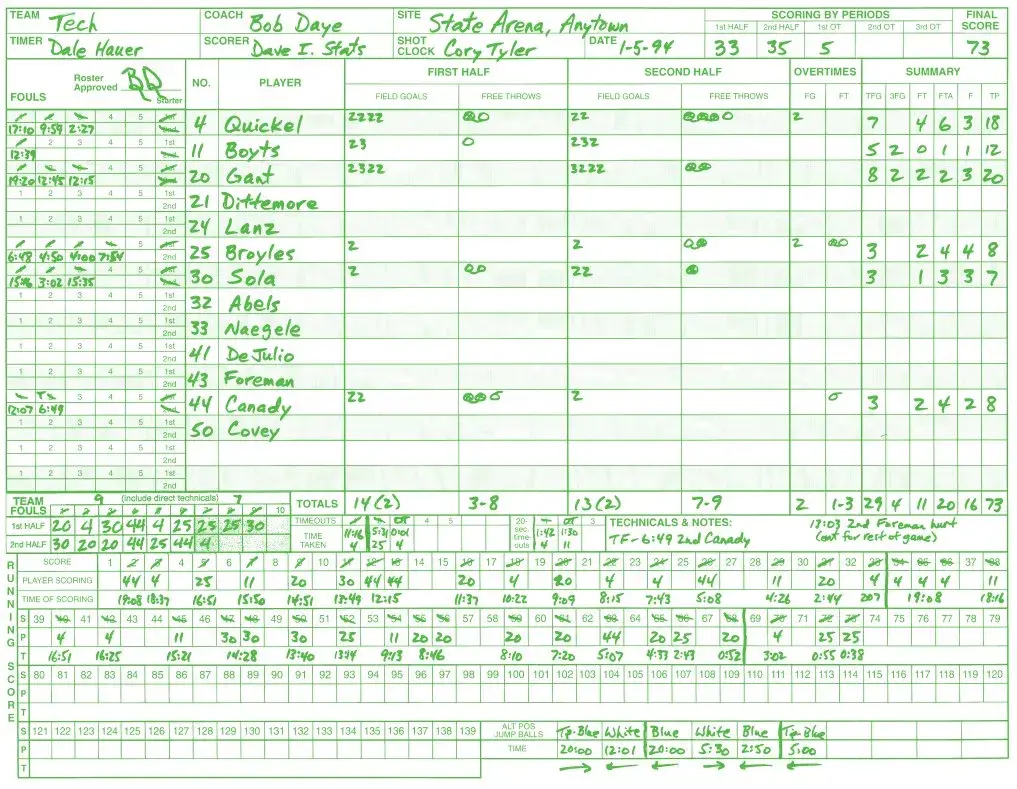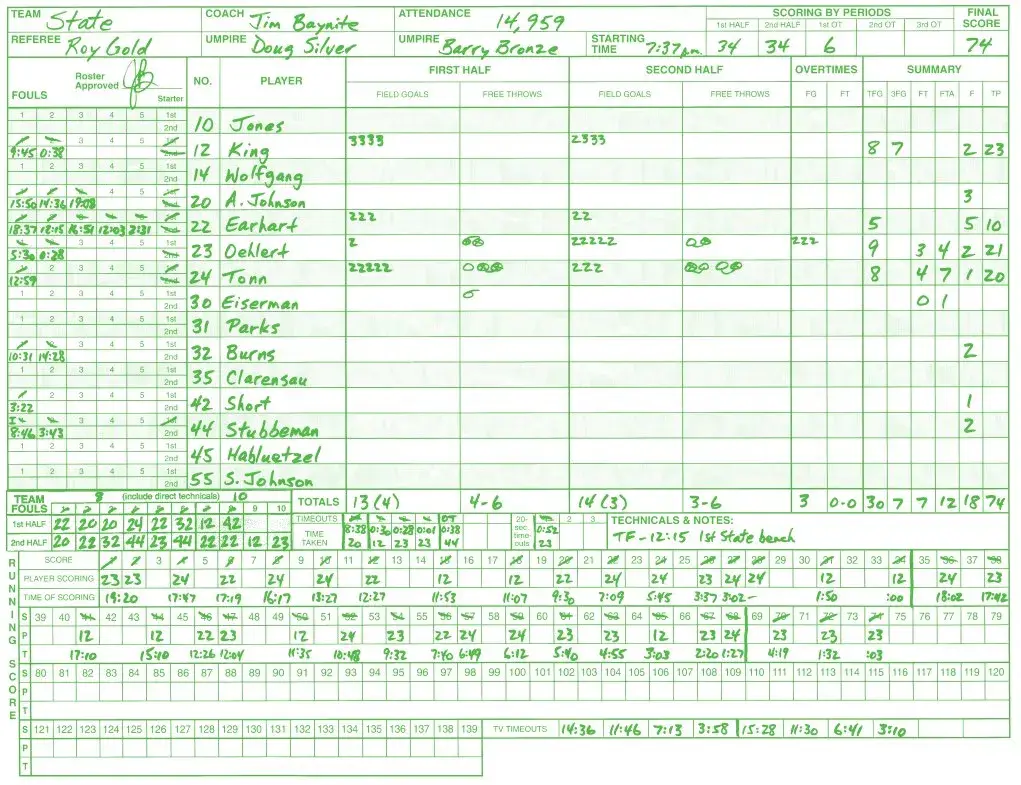In the dynamic world of collegiate basketball, the role of keeping accurate game records cannot be overstated, and here, the NCAA Basketball Scorebook plays a pivotal role. This Official NCAA Basketball Scorebook, endorsed by the National Association of Basketball Coaches, is designed not only to streamline the scoring process but also to ensure uniformity across all college games, thereby maintaining integrity and precision in the documentation of game statistics. This comprehensive tool facilitates the recording of essential game elements such as player statistics, fouls, and the running score, offering spaces for up to 40 games. With sections meticulously laid out for scoring by periods, player and team fouls, field goals, free throws, and timeouts, among others, the scorebook is a testament to the NCAA's commitment to accuracy and attention to detail. It serves as a crucial reference for coaches, officials, and statisticians alike, ensuring that every point, play, and penalty is duly noted, following the official scoring rules and instructions. Moreover, its publication and distribution by the NCAA from their Indianapolis office highlight the importance placed on standardized scoring practices in reinforcing the fairness and competitive spirit of collegiate basketball. In essence, the NCAA Basketball Scorebook is more than just a record-keeping pamphlet; it's a cornerstone of the sport's integrity and a key instrument in the accurate and fair reporting of college basketball games.
| Question | Answer |
|---|---|
| Form Name | Ncaa Basketball Scorebook Form |
| Form Length | 94 pages |
| Fillable? | No |
| Fillable fields | 0 |
| Avg. time to fill out | 23 min 30 sec |
| Other names | official scorebook, basketball scorebook sheets, ncaa basketball score sheet, ncaa basketball scorebook |
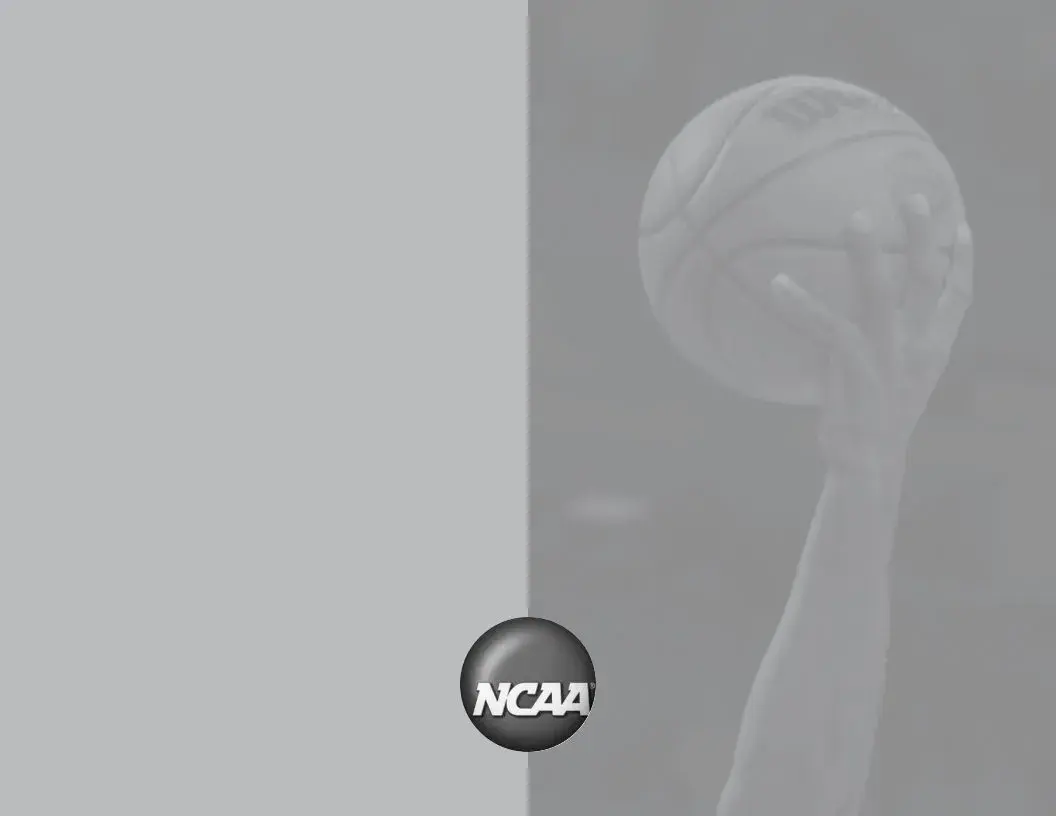
OFFICIAL NCAA BASKETBALL
SCOREBOOK
Published by the
National Collegiate Athletic Association
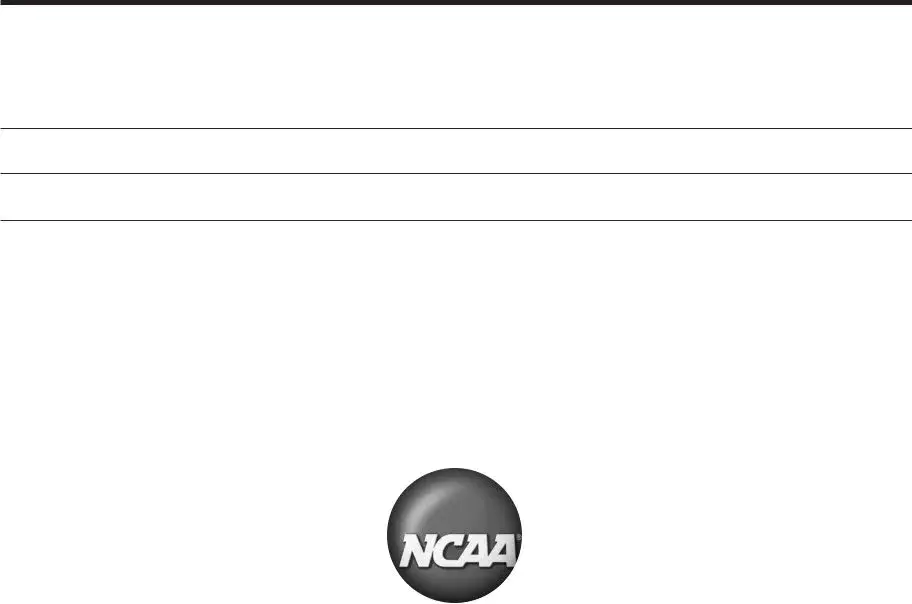
The Official
National Collegiate Athletic Association
Basketball Scorebook
Approved by the National Association of Basketball Coaches
Contemporary Format with Scoring Space for 40 Games/Official Scoring Rules and Instructions for Scoring
Produced and Distributed by
NCAA PUBLISHING
P.O. Box 6222, Indianapolis, Indiana,
http://www.ncaa.org
NCAA
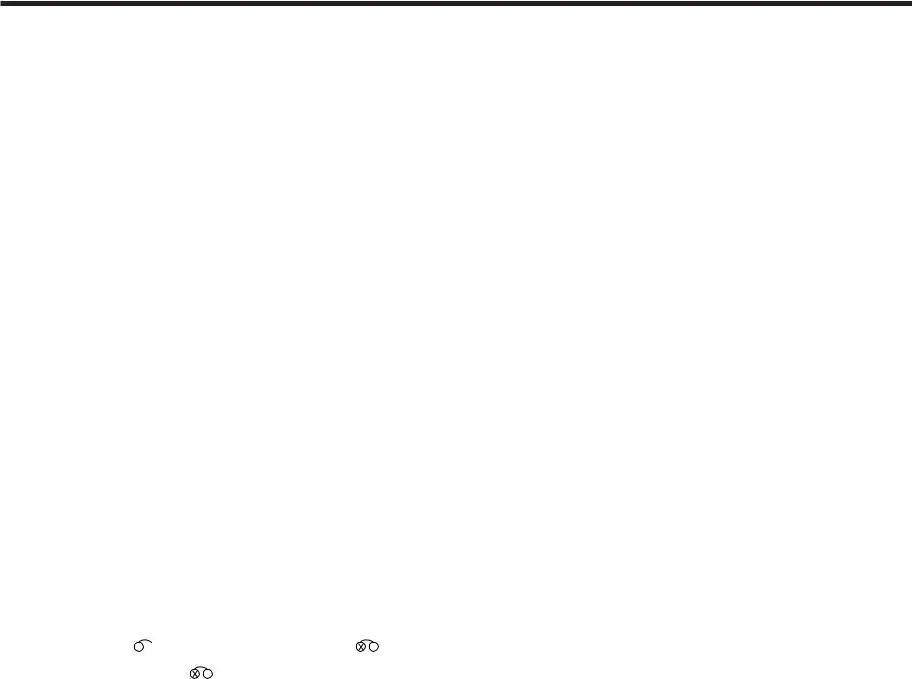
How to use the Official NCAA Basketball Scorebook
(Refer also to the Official Scoring Rules and sample Scoring Sheet)
The Official NCAA Basketball Scorebook is published and distributed by the NCAA to provide coaches and officials with a uniform, official scorebook. Its use as the only official scoring form, especially for all collegiate games, will standardize basketball scoring and assure a proper and complete record of all games played, whether home or away.
The form includes all statistical columns along with the running score for which the official scorer is responsible, as stated in the official NCAA Men’s and Women’s Basketball Rules and Interpretations. Actual player statistics that are commonly
GENERAL INFORMATION: The top boxes across both scoring pages give general information about the game being scored, including the teams involved and their coaches, the date, site and attendance, and the names of the officials involved in the contest.
SCORING BY PERIODS: In the boxes provided, record the number of points actually scored in each period of play. Only the final score should be cumulative, as the running score gives cumulative totals at the end of each period. A suggested method for scoring is to use a different ink color for each half and each overtime period.
NUMBER AND PLAYER COLUMNS: Before the start of the game, the last name and number of each squad member dressed for and eligible to play in the game should be recorded in the appropriate spaces. It is recommended in the official NCAA rules book that the squad members’ names be entered in the scorebook in numerical order. Space is provided at the top of the roster for an official from each team (preferably a coach) to initial the approval of the roster before the game begins.
FOULS: Each time a personal foul or direct technical foul is charged to a player, make a slash through the next available number (1, 2, etc.) to keep a correct total of the number of fouls charged to each player. Some scorers differentiate second- half fouls from
FIELD GOALS: After each successful field goal by a player, mark a “2” or “3” in the
FREE THROWS: Record each free throw attempted and made in the proper half
or overtime space.  before the free throw is attempted. If the free throw is successful, put an X inside the
before the free throw is attempted. If the free throw is successful, put an X inside the  .
.
Indicate  and
and  . Indicate
. Indicate
shot is successful, and by  if both shots are successful. If the second shot is
if both shots are successful. If the second shot is
unsuccessful, leave the marking as .
OFFICIAL SUMMARY COLUMNS: At the end of the game, the figures recorded for each player should be totaled and placed in the proper column in the official
summary area. Totals should be recorded for total field goals made,
TOTALS LINE BENEATH SCORING AREA: Vertically total the field goals, three- point field goals and free throws for each half and enter on the totals line to check figures above with running score below.
TEAM FOULS: Mark off each personal, unsporting technical or contact technical foul charged to each team to determine bonus
TIMEOUTS: Mark each timeout charged to a team, and use the space below to indicate the time at which it was taken (from the game clock) to help substantiate the number recorded. Some scorers also record in this space the number of the player who called the timeout. Use the extra blank spaces to record timeouts in overtime games. Use the space provided on the
TECHNICALS & NOTES: This is the official scorer’s “free” space and may be used for the recording of any pertinent data relative to the game being played for which space is not otherwise provided. An example of this type of information is a foul charged to a coach, other bench personnel, a follower, a player ejected for fighting, or an injured player.
RUNNING SCORE: The running score is among the most important tasks of the official scorer, because it represents the actual game score as the game progresses and is the official score of the game at any point in time. Mark out the correct numbered squares as each point is scored. The optional spaces below may be used to indicate the number of the player scoring and the approximate time remaining in the half when the points were scored.
ALTERNATE POSSESSION: This space is used to keep track of team possession when a “held ball” situation occurs. Actual center jumps are used only to start the contest and to start each overtime period. The
The NCAA publishes a complete manual for the basketball statistician, the Basketball Statisticians’ Manual, which is available for $5 from NCAA Publishing, phone:

Official Scoring and Timeout Rules
(Reprinted from the NCAA Men’s and Women’s Basketball Rules and Interpretations)
Section 12. Duties of Scorers
The scorers shall:
ART. 1. Record the names and uniform numbers of squad members who may participate and those of the starting five players.
ART. 2. Record the field goals made and the free throws made and missed, and keep a running summary of the points scored.
ART. 3. Record the personal and technical fouls called on each player and the technical fouls called on a coach, squad member, bench personnel or follower.
ART. 4. Notify an official immediately when the fifth foul, including any combination of personal fouls, direct technical fouls, intentional personal fouls and (men) intentional technical fouls; or the third technical foul is charged to a squad member or bench personnel.
A.R. 29. B1 commits a fifth foul [any combination of personal fouls, direct technical fouls, and (men) intentional technical fouls], which results in two free throws for A1. The official scorer and official timer fail to notify any of the game officials that a fifth foul has been committed. When the scorers realize the mistake, they inform the official timer to sound the
A.R. 30. A player who has committed a fifth foul (any combination of personal fouls, direct technical fouls and (men) intentional technical fouls) continues to play because the scorers have failed to notify the officials. RULING: As soon as the scorers discover the irregularity, they should sound the
ART. 5. Notify an official immediately when a second direct technical foul is charged to a coach, squad member or any bench personnel.
ART. 6. (MEN) Notify an official immediately when two intentional technical fouls or a combination of one intentional technical foul and one direct technical foul have been assessed to a squad member.
ART. 7. Notify an official immediately when a combination of any three technical fouls has been assessed or when three bench direct technical fouls have been called on a team.
ART. 8. Record any ejection for fighting.
ART. 9. Record the timeouts charged to each team and notify a team and its head coach, through an official, when such team takes its final allowable charged timeout. ART. 10. Signal the nearest official each time a team is granted a charged timeout in excess of the allowable number.
11. Signal the nearest official in each half when a player commits a common foul (except a
direct technical fouls, (men) intentional technical fouls and flagrant technical fouls. ART . 12. Designate that the scorebook of the home team shall be the official scorebook, unless the referee rules otherwise. The official scorebook shall remain at the scorers’ table throughout the game, including all intermissions.
A.R. 31. At halftime, the official scorer, who is a member of the
ART. 13. Compare their records after each goal, each foul and each charged timeout, notifying the referee at once of any discrepancy. When no error can be found, the referee shall accept the record of the official scorebook, unless the referee has knowledge that permits another decision. When the discrepancy is in the score and the error is not resolved, the referee shall accept the progressive team totals of the official scorebook.
14. Correct a scoring or bookkeeping mistake any time before the referee approves the final score.
A.R. 32. The official scorer fails to record two points awarded to Team A by an official during the first half as a result of basket interference by B2. RULING: The bookkeeping mistake shall be rectified.
A.R. 33. After two minutes of the first extra period, it is discovered that during the second half of regulation play, the official scorer failed to record one point as a result of a made free throw by Team A. RULING: The score shall be recorded and play shall be continued at a designated spot from the point of interruption.
15. Keep a record in the scorebook of the names and uniform numbers of players who are to start the game and of all substitutes who enter the game.
a.It is recommended that squad members’ names be entered in the scorebook in numerical order.
ART. 16. Notify the nearest official when there is an infraction of the rules pertaining to submission of the roster, substitutions or uniform numbers of players.
ART. 17. When necessary, signal the officials with a sounding device unlike that used by the referee and umpire(s). This sounding device may be used immediately when (or as soon as) the ball is dead or is in control of the offending team.
A.R. 34. When may a scorer signal? RULING: When the scorer desires to call attention to a player who is illegally in the game, the scorer may signal the official when the ball is in control of that player’s team or when the ball becomes dead. When it is for a substitution, the scorer may signal when the ball next becomes dead and the clock is stopped. When it is for conferring with an official, the scorer may signal when the ball is dead. When the scorer signals while the ball is live, the official shall ignore the signal when a scoring play is in progress. Otherwise, the official may signal for the game clock to be stopped to determine the reason for the signal.
A.R. 35. The
ART. 18. When a correctable error is called to the official scorer’s attention by a coach while the game clock is running, the timer shall not use the
ART. 19. For ease of identifying the official scorer, one of the following shall be placed on the floor in front of the individual’s spot at the scorers’ table:
a.An “X” composed of
b.An NCAA logo that is a minimum of approximately 8 inches in diameter.
c.An NCAA Basketball logo that is a rectangle approximately
NOTE: It is recommended that only the person at the scorers’ table permitted to wear a
Section 11. Charged Timeouts
ART. 1. Time shall be out and the game clock and shot clock, if running, shall be stopped when:
a.A player or head coach requests a timeout, such request being granted only when the player’s/coach’s team is in possession of the ball (this includes that team’s
b.An injured player or a player who is bleeding or has a uniform that is saturated with blood has that condition remedied and is permitted to remain in the game.
A.R. 127. Both teams remain in their huddles after a timeout even though the official administering the
ART. 2. A timeout shall not be granted until after the jump ball that begins the game and the conditions as described in Rule
ART. 3. In games not involving electronic media and also those with typed Internet coverage but WITHOUT audio or video broadcast, the timeout format shall be:
a.Four
b.The four
c.The two
d.A player or a coach from the same team may request successive
1.When successive timeouts are granted, players are permitted to sit on their bench only when the request has been made in advance.
2.When successive
e.When there is an extra period(s), each team shall be entitled to one extra 75- second timeout per extra period in addition to any timeouts it has not used previously.
1.The extra timeout shall not be granted until after the ball becomes live
to begin the extra period(s).
f.Cheerleaders and mascots are permitted on the playing court only during a full timeout or an intermission.
g.Bands/amplified music are permitted to play or be played only during any timeout or intermission.
ART. 4. In games involving electronic media (i.e., radio, television, or Internet audio or visual broadcast), when the
(TELEVISION, RADIO OR INTERNET AUDIO OR VISUAL BROADCAST MUST BE PRESENT TO USE THIS
a.When television is employed, there shall be four
1.The first timeout requested by either team in the second half shall become the length of a timeout called for by the
2.When the first timeout requested by either team in the second half is granted and creates the first dead ball after one of the
NOTE: For NCAA Division I tournament games, the men’s or women’s Division I basketball committee may make the first
b.When radio or Internet audio or visual broadcast is being used, electronic- media timeouts shall occur at the first dead ball after the
1.The first timeout requested by either team in the second half shall be 75 seconds long or longer when called for by the
2.When the
c.Each team shall be entitled to four timeouts, 30 seconds each in length.
d.Each team may carry up to three
e.Each team shall be entitled to one
1.No conference shall be permitted to extend the
f.A player or a coach from the same team may request successive
1.When these successive timeouts are granted, players shall be allowed to sit on their bench only when the request has been made in advance.
2.When successive
g.Unused
h.A
1.When a request has been made to shorten a timeout for a purpose other than a substitution(s), a warning signal shall be sounded immediately and 15 seconds later a
2.When a request is made to shorten any timeout for a substitution(s), the signal for shortening a timeout shall be given and play shall be resumed immediately.
i.Each team shall be entitled to one additional
1.The extra timeout shall not be granted until after the jump ball that begins the extra period and the conditions as described in Rule
2.The first timeout requested in any extra period may become an
j.Cheerleaders and mascots are permitted onto the playing court only during an
k.Bands and amplified music are permitted to play or be played only during any timeout or intermission.
NOTE: (men) For Division II Men’s NCAA tournament games, the format described in Rule
ART. 5. When the
a.Four
b.The four
c.The two
d.When there is an extra period(s), each team is entitled to one extra
e.When the
ART. 6. In games involving electronic media, when a foul (personal or technical) is committed that causes the ball to become dead at one of the specified time marks on the game clock for
ART. 7. In games involving electronic media, when a timeout has been recognized to be shortened for the sole purpose of making substitutions and the timeout causes the first dead ball after one of the specified time marks for
ART. 8. When a
ART. 9. When a
ART. 10. A single charged full timeout in games not involving electronic media shall not exceed 75 seconds.
ART. 11. A single charged
ART. 12. A single charged
ART. 13. Only one
ART. 14. A warning signal to alert teams to prepare to resume play shall be sounded 15 seconds before the expiration of any charged or
ART. 15. A second
ART. 16. Substitutions shall not occur after the warning signal to prepare to resume play until at least one
ART. 17. During a
ART. 19. Successive charged timeouts shall not be granted after the expiration of playing time for the second half or after the expiration of any extra period.
A.R. 128. After the second half expires with the score tied, A1 is charged with a flagrant technical foul. Either Team A or Team B then
A.R. 129. After the second half expires with the score tied, Team A requests a
ART. 20. The team that requests a timeout may shorten that timeout when the captain/head coach notifies the official of the team’s intent.
a.When a request has been made to shorten any timeout for a purpose other than for substitution(s), a warning signal shall be sounded immediately and 15 seconds later another signal shall be sounded to resume play.
b.When a request is made to shorten any timeout for a substitution(s), the signal for shortening a timeout shall be given and play shall be resumed immediately.
ART. 21. A timeout shall be charged to a team for either length or fraction thereof consumed under Rules
A.R. 130. Team A coach requests a timeout for an official to assess whether a correctable error has occurred. The error is (a) correctable or; (b) not correctable. RULING: In (a) when the error is correctable, no timeout shall be charged to Team A. In (b) when the error is not correctable, a timeout shall be charged to Team A. When any portion of that timeout remains after the review of the request has been conducted, Team A shall be entitled to use that time. When the review requires the length of a timeout or longer, play shall resume immediately from the point at which it was interrupted at a designated spot.
TIMEOUT COMPARISON CHART
Type of Game |
|
Team Timeouts |
|
Team Timeouts |
|
Team Timeouts |
|
Electronic Media |
|
Electronic Media |
|
Media Timeouts |
|
|
|
|
|
|
|||||||
|
|
1st Half |
|
2nd Half |
|
Extra Periods |
|
Timeouts 1st Half |
|
Timeouts 2nd Half |
|
Extra Periods |
No electronic |
|
Four |
|
Any not used in |
|
Any not used in |
|
None |
|
None |
|
None |
media or Internet |
|
two |
|
first half. |
|
regulation or any |
|
|
|
|
|
|
coverage without |
|
timeouts per team |
|
|
|
prior extra period(s) |
|
|
|
|
|
|
audio or video. |
|
per regulation game. |
|
|
|
plus one |
|
|
|
|
|
|
(Rule |
|
All carry over to |
|
|
|
timeout per team for |
|
|
|
|
|
|
|
|
second half if not |
|
|
|
each extra period. |
|
|
|
|
|
|
|
|
used in first half. |
|
|
|
|
|
|
|
|
|
|
Radio, Internet |
|
Same as above. |
|
Same as above. |
|
Same as above. |
|
Either two, one or none, depending on |
|
Either two, one or no more, depending |
|
The first |
with audio or |
|
|
|
|
|
|
|
the media agreement. The length shall |
|
on the media agreement. The length |
|
timeout in each period |
visual broadcast |
|
|
|
|
|
|
|
be determined by media agreement. |
|
shall be determined by media |
|
becomes a media |
and media agree- |
|
|
|
|
|
|
|
Each shall occur at the first dead ball |
|
agreement. Each shall occur at the first |
|
timeout, if that is part |
ment that calls for |
|
|
|
|
|
|
|
after the minute mark specified in the |
|
dead ball after the minute mark |
|
of the media |
fewer than three |
|
|
|
|
|
|
|
media agreement. When either team |
|
specified in the media agreement. |
|
agreement. |
timeouts in at |
|
|
|
|
|
|
|
uses a |
|
When either team uses a |
|
|
least one half. |
|
|
|
|
|
|
|
that timeout replaces the next agreed- |
|
timeout in the half, that timeout re- |
|
|
|
|
|
|
|
|
|
|
upon media timeout of the half. |
|
places the next |
|
|
|
|
|
|
|
|
|
|
|
|
timeout of the half. |
|
|
Television |
|
Four |
|
Each team carries |
|
Any not used in re- |
|
Four media timeouts, the length of |
|
Four more media timeouts, the length |
|
Same as above. |
|
|
timeouts and one 60- |
|
over any unused |
|
gulation, second half |
|
which is determined by media |
|
of which is determined by media |
|
|
|
|
second timeout per |
|
timeouts from the |
|
or any previous extra |
|
agreement. These timeouts shall |
|
agreement. These timeouts shall occur |
|
|
|
|
team. |
|
first half but no more |
|
period(s) plus one |
|
occur at the first dead ball after the |
|
at the first dead ball after the |
|
|
|
|
|
|
than three |
|
extra |
|
|
8- and |
|
|
|
|
|
|
|
timeouts each. The |
|
timeout per team per |
|
team’s |
|
second timeout called by either team |
|
|
|
|
|
|
fourth is lost if it |
|
extra period. |
|
extended by media agreement. |
|
in this half only shall be 75 seconds |
|
|
|
|
|
|
was not used in the |
|
|
|
|
|
long or a media timeout, the length of |
|
|
|
|
|
|
first half. The first 30- |
|
|
|
|
|
which is determined by media |
|
|
|
|
|
|
second timeout |
|
|
|
|
|
agreement. Neither team’s |
|
|
|
|
|
|
requested by either |
|
|
|
|
|
timeout can be extended by media |
|
|
|
|
|
|
team in this half only |
|
|
|
|
|
agreement. |
|
|
|
|
|
|
becomes a media |
|
|
|
|
|
|
|
|
|
|
|
|
timeout, the length of |
|
|
|
|
|
|
|
|
|
|
|
|
which is determined |
|
|
|
|
|
|
|
|
|
|
|
|
by the media |
|
|
|
|
|
|
|
|
|
|
|
|
agreement. |
|
|
|
|
|
|
|
|
|
|
|
|
|
|
|
|
|
|
|
|
|
Radio, Internet |
|
Same as above. |
|
Same as above. |
|
Same as above. |
|
Three media timeouts, the length of |
|
The |
|
Same as above. |
with audio or |
|
|
|
|
|
|
|
The |
|
occur after the |
|
|
visual broadcast |
|
|
|
|
|
|
|
shall occur after the |
|
|
|
|
and media format |
|
|
|
|
|
|
|
8- and |
|
10- and |
|
|
calls for at least |
|
|
|
|
|
|
|
the |
|
on the media agreement. The first |
|
|
three media |
|
|
|
|
|
|
|
depending on the media agreement. |
|
|
|
|
timeouts in |
|
|
|
|
|
|
|
Neither team’s |
|
team in this half only shall become a |
|
|
either half. |
|
|
|
|
|
|
|
can be extended by media |
|
media timeout, the length of which is |
|
|
|
|
|
|
|
|
|
|
agreement. |
|
determined by media agreement. |
|
|
|
|
|
|
|
|
|
|
|
|
Neither team’s |
|
|
|
|
|
|
|
|
|
|
|
|
be extended by media agreement. |
|
|
|
|
|
|
|
|
|
|
|
|
|
|
|
